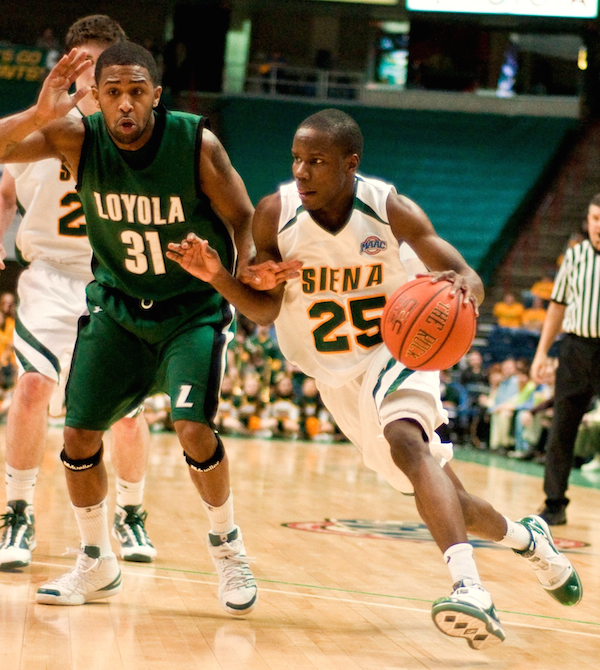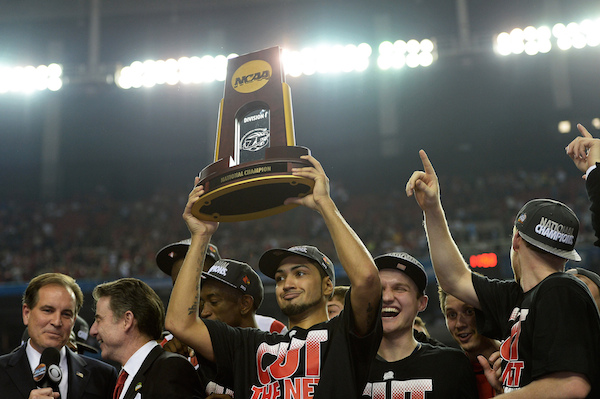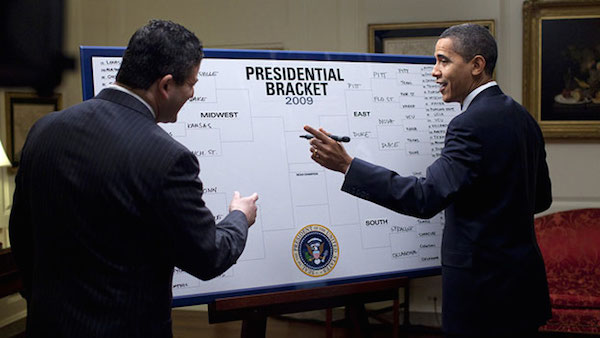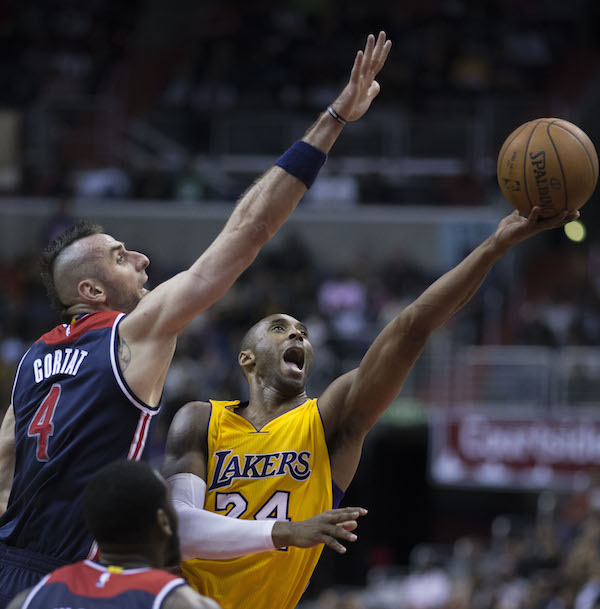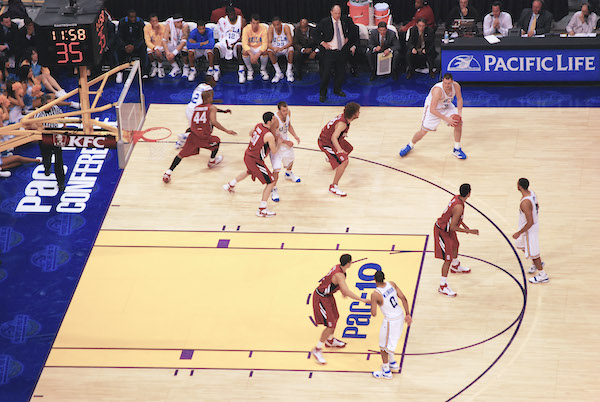We’re interrupting our normal daily sports forecasts to concentrate on March Madness, the NCAA men’s basketball tournament and American cultural obsession. We’ll run you through the games each day and give you a little flavor for each one.
NCAA Men’s Basketball – #15 New Mexico State Aggies vs. #2 Kansas Jayhawks, 12:15 p.m. ET on CBS.
After yesterday’s historic insanity, it’s probably too much to hope for for this game to be close. Then again, if there was going to be a 2 seed that gets a real scare in the first round, it would be Kansas. Most of the computer rankings say that Kansas should be flattered to have even gotten ranked so highly by the tournament’s seeds.
NCAA Men’s Basketball – #10 Georgia Bulldogs vs. #7 Michigan State Spartans, 12:40 p.m. ET on TRU.
If you wanted an exhibit to show that coaching does matter in sports, particularly college basketball, you couldn’t find a better one than Michigan State Coach Tom Izzo. Despite not having the best players most years, his teams always seem to win at least a game or two in March Madness. They are favored over a solid but unspectacular Georgia team.
NCAA Men’s Basketball – #12 Wyoming Cowboys vs. #5 Northern Iowa, 1:40 p.m. ET on TBS.
With all of yesterday’s upsets, the two 5 seeds actually managed to beat the 12 seeds they faced. The 12 over 5 upset is the one that armchair pundits (and we’re all armchair pundits, aren’t we?) everywhere look for. It just seems like at least one 12 seed always beats a 5. 538 ran an interesting article on why this might actually be true. Will Wyoming pull it off?
NCAA Men’s Basketball – #12 Buffalo Bulls vs. #5 West Virginia Mountaineers, 2:10 p.m. ET on TNT.
Or, maybe it’s Buffalo’s turn? Normally at this time of the year we’d see stories about how the snow struck city of Buffalo could really use something to cheer them up but this year, compared to Boston, living in Buffalo was like having a time-share in Palm beach. It’s hard to root against West Virginia and their pressing defense.
NCAA Men’s Basketball – #10 Indiana Hoosiers vs. #7 Wichita State Shockers, 2:45 p.m. ET on CBS.
This is one of the few NCAA Tournament games that feels like a preview to coming attractions. If Wichita State can get by the Indiana Hoosiers, it will (probably) set up a matchup with in-state rival Kansas on Sunday. Everyone outside of Indiana is rooting for this to happen but I wonder if Wichita’s players will be guilty of looking ahead and get caught for it here.
NCAA Men’s Basketball – #15 Belmont Bruins vs. #2 Virginia Cavaliers, 3:10 p.m. ET on TRU.
It seems funny to stick a 2 seed on TRU TV but Virginia is no normal 2 seed. They play a slow, grind-it-out, defensive game. I guess the TV schedulers might have felt that their play was too slow for most viewers. I have to say, I’m curious to see it. The slower you play, the fewer possessions the game has, and the fewer possessions the game has, the higher the chance for luck to play a role in the outcome. Maybe Belmont can get a few bounces and keep this close or even win?!
NCAA Men’s Basketball – #13 UC Irvine Anteaters vs. #4 Louisville Cardinals, 4:10 p.m. ET on TBS.
THE ANTEATERS ARE GOING TO WIN, THE ANTEATERS ARE GOING TO WIN! Here’s a quote from the Wikipedia page on anteaters: “When a territorial dispute occurs, they vocalize, swat, and can sometimes sit on or even ride the back of their opponents.” THAT’S WHAT THEY’RE GOING TO DO!
NCAA Men’s Basketball – #13 Valparaiso Crusaders vs. #4 Maryland Terrapins, 4:40 p.m. ET on TNT.
Take some time before this game to read Jeremy Pahl’s wonderful article about growing up in Valparaiso and what basketball meant to him, his father, and the whole city. You’ll be pulling for the Crusaders afterwards.
NCAA Men’s Basketball – #9 Oklahoma State Cowboys vs. #8 Oregon Ducks, 6:50 p.m. ET on TBS.
Oklahoma State lost six of its last seven games before today. It’s hard to imagine that they’ll just be able to snap out of it and win this game but stranger things have happened. Actually, about ten stranger things happened yesterday. Hmm…
NCAA Men’s Basketball – #16 Robert Morris Dentists vs. #1 Duke Blue Devils, 7:10 p.m. ET on CBS.
What an amazing matchup! Dentists vs. Devils — hard to say which one is worse. Just kidding, the Robert Morris team is actually called the Colonials, not the Dentists, but how great would that be? Duke is the team that most of the country loves to hate and, knowing that a 16 seed has never beaten a 1 seed, my guess is that we’ll all get to hate Duke for a little while longer.
NCAA Men’s Basketball – #10 Davidson Wildcats vs. #7 Iowa Hawkeyes, 7:20 p.m. ET on TNT.
The funny thing about this game is that despite making the tournament, both these teams are afterthoughts in their own states. Iowa is not thought to be as good as Iowa State or Northern Iowa and Davidson, located in North Carolina, is nowhere near as good as North Carolina or Duke. It kind of makes me want them both to win, although that is obviously impossible.
NCAA Men’s Basketball – #14 Albany Great Danes vs. #3 Oklahoma Sooners, 7:27 p.m. ET on TRU.
In case you’re wondering what a “Sooner” is, it’s a historical reference. A sooner was someone who jumped the gun and entered Oklahoma to claim what once was Native American land for themselves just before President Grover Cleveland legalized the land-rush in 1889. Perhaps not quite as bad as the Ole Miss Rebels historical nickname, it’s still pretty despicable. I guess we should all root for the dogs that look like horses team?
NCAA Men’s Basketball – #16 Coastal Carolina Chanticleers vs. #1 Wisconsin Badgers, 9:20 p.m. ET on TBS.
Wisconsin is famous for choking in the NCAA Tournament and losing when they’re expected to win. If they do it tonight, they’ll be famous for it forever and ever.
NCAA Men’s Basketball – #9 St. John’s Red Storm vs. #8 San Diego State Aztecs, 9:40 p.m. ET on CBS.
Alas, St. John’s big man, Chris Obepka, who made a name for himself this year for wearing short(er) shorts, is suspended for the tournament, so we won’t be graced by his leggy presence. Having seen St. John’s play in person just a week ago, I suspect we may not be graced by any of their presences for long. They didn’t seem like a very good basketball team to me.
NCAA Men’s Basketball – #15 North Dakota State Bison vs. #4 Gonzaga Bulldogs, 9:57 p.m. ET on TRU.
Give yourself a pat on the back if you make it through to this game. That’s a lot of basketball in two days! Rest up, ’cause there’s more on Saturday and Sunday!


